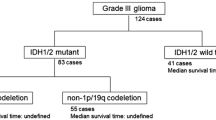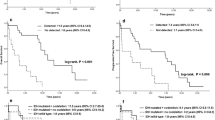Abstract
Purpose
Lower grade gliomas with 1p/19q codeletion are often responsive to chemotherapy, and several of these have been treated using upfront chemotherapy and subsequent resection following tumor volume decrease. This study aimed to elucidate the histological changes and the mechanism of recurrence after alkylating agent chemotherapy in 1p/19-codeleted gliomas.
Methods
Fourteen 1p/19q-codeleted gliomas resected following tumor volume decrease after alkylating agent chemotherapy were included and compared with their pre-chemotherapy specimens. Histological changes were investigated using hematoxylin–eosin staining, and changes in proliferative activity, status of glioma stem cells (GSCs), and tumor-infiltrating macrophages were assessed using immunohistochemistry for Ki-67/MIB-1, CD68 as a pan-macrophage/monocyte marker, CD163 as a presumed marker of M2 polarity, and nestin and CD133 as markers of GSCs.
Results
The most frequent histological findings following chemotherapy included a sparse glial background and abundant foamy cell infiltration. The Ki-67/MIB-1 index decreased and the number of CD68 + cells increased after chemotherapy. The increasing rate of CD68 + cells in the post-/pre-chemotherapy specimens was inversely correlated with patient prognosis but not tumor response. The number of CD163 + cells, M2/M1 + M2 ratio, and the ratio of GSCs to total tumor cells increased after chemotherapy, and those in the post-chemotherapy specimens were negatively correlated with patient prognosis. There was a correlation between the M2/M1 + M2 ratio and the ratio of GSCs in both pre- and post-chemotherapy specimens.
Conclusion
GSCs in conjunction with M2 macrophages constitute the mechanism of resistance to and recurrence after alkylating agent chemotherapy in 1p/19q-codeleted gliomas.




Similar content being viewed by others
Data availability
Raw data of the findings of the study are available in Table S1.
Code availability
The code is available from the corresponding author, upon reasonable request.
References
Darnton SJ, Allen SM, Edwards CW, Matthews HR (1993) Histopathological findings in oesophageal carcinoma with and without preoperative chemotherapy. J Clin Pathol 46(1):51–55
Langer R, Ott K, Feith M, Lordick F, Siewert JR, Becker K (2009) Prognostic significance of histopathological tumor regression after neoadjuvant chemotherapy in esophageal adenocarcinomas. Mod Pathol 22(12):1555–1563
Kurosumi M, Akashi-Tanaka S, Akiyama F et al (2008) Histopathological criteria for assessment of therapeutic response in breast cancer (2007 version). Breast Cancer 15(1):5–7
Schiffer D, Giordana MT, Buoncristiani P, Paoletti P (1978) Human malignant gliomas treated with chemotherapy: a pathological study. Neurosurgery 3(3):344–347
Schiffer D, Giordana MT, Paoletti P, Soffietti R, Tarenzi L (1980) Pathology of human malignant gliomas after radiation and chemotherapy. Acta Neurochir 53(3–4):205–216
Fischer I, Cunliffe CH, Bollo RJ et al (2008) High-grade glioma before and after treatment with radiation and Avastin: initial observations. Neuro Oncol 10(5):700–708
DeLay M, Jahangiri A, Carbonell WS et al (2012) Microarray analysis verifies two distinct phenotypes of glioblastomas resistant to antiangiogenic therapy. Clin Cancer Res 18(10):2930–2942
Woo JY, Yang SH, Lee YS, Lee SY, Kim J, Hong YK (2015) Continuous low-dose temozolomide chemotherapy and microvessel density in recurrent glioblastoma. J Korean Neurosurg Soc 58(5):426–431
Tamura R, Tanaka T, Miyake K et al (2016) Histopathological investigation of glioblastomas resected under bevacizumab treatment. Oncotarget 7(32):52423–52435
Sasaki H, Hirose Y, Yazaki T et al (2015) Upfront chemotherapy and subsequent resection for molecularly defined gliomas. J Neurooncol 124(1):127–135
Louis DN, Ohgaki H, Wiestler OD, et al. (2016) WHO classification of tumours of the central nervous system. Revised 4th edn. Lyon: International Agency for Research on Cancer
Kitamura Y, Sasaki H, Kimura T et al (2013) Molecular and clinical risk factors for recurrence of skull base chordomas: gain on chromosome 2p, expression of brachyury, and lack of irradiation negatively correlate with patient prognosis. J Neuropathol Exp Neurol 72(9):816–823
Cui L, Rashdan NA, Zhu D et al (2017) End stage renal disease-induced hypercalcemia may promote aortic valve calcification via annexin VI enrichment of valve interstitial cell derived-matrix vesicles. J Cell Physiol 232(11):2985–2995
Strojnik T, Røsland GV, Sakariassen PO, Kavalar R, Lah T (2007) Neural stem cell markers, nestin and musashi proteins, in the progression of human glioma: correlation of nestin with prognosis of patient survival. Surg Neurol 68(2):133–143
Zhang M, Song T, Yang L et al (2008) Nestin and CD133: valuable stem cell-specific markers for determining clinical outcome of glioma patients. J Exp Clin Cancer Res 27(1):85
van den Bent MJ, Wefel JS, Schiff D et al (2011) Response assessment in neuro-oncology (a report of the RANO group): assessment of outcome in trials of diffuse low-grade gliomas. Lancet Oncol 12(6):583–593
Blumenthal DT, Aisenstein O, Ben-Horin I et al (2015) Calcification in high grade gliomas treated with bevacizumab. J Neuro-Oncol 123(2):283–288
Sethi D, Sen R, Parshad S, Khetarpal S, Garg M, Sen J (2012) Histopathologic changes following neoadjuvant chemotherapy in various malignancies. Int J Appl Basic Med Res 2(2):111–116
Liu G, Yuan X, Zeng Z et al (2006) Analysis of gene expression and chemoresistance of CD133+ cancer stem cells in glioblastoma. Mol Cancer 5:67
Fillmore CM, Kuperwasser C (2008) Human breast cancer cell lines contain stem-like cells that self-renew, give rise to phenotypically diverse progeny and survive chemotherapy. Breast Cancer Res 10(2):R25
Tanei T, Morimoto K, Shimazu K et al (2009) Association of breast cancer stem cells identified by aldehyde dehydrogenase 1 expression with resistance to sequential paclitaxel and epirubicin-based chemotherapy for breast cancers. Clin Cancer Res 15(12):4234–4241
Aomatsu N, Yashiro M, Kashiwagi S et al (2012) CD133 is a useful surrogate marker for predicting chemosensitivity to neoadjuvant chemotherapy in breast cancer. PLoS ONE 7(9):e45865
Dell’Albani P (2008) Stem cell markers in gliomas. Neurochem Res 33(12):2407–2415
Dahlrot RH, Hermansen SK, Hansen S, Kristensen BW (2013) What is the clinical value of cancer stem cell markers in gliomas? Int J Clin Exp Pathol 6(3):334–348
Wu B, Sun C, Feng F, Ge M, Xia L (2015) Do relevant markers of cancer stem cells CD133 and Nestin indicate a poor prognosis in glioma patients? A systematic review and meta-analysis. J Exp Clin Cancer Res 34(1):44
Martinez FO, Gordon S (2014) The M1 and M2 paradigm of macrophage activation: time for reassessment. F1000Prime Rep. 6:13
Tamura R, Tanaka T, Yamamoto Y, Akasaki Y, Sasaki H (2018) Dual role of macrophage in tumor immunity. Immunotherapy 10(10):899–909
Zeiner PS, Preusse C, Golebiewska A et al (2019) Distribution and prognostic impact of microglia/macrophage subpopulations in gliomas. Brain Pathol 29(4):513–529
Hao NB, Lü MH, Fan YH, Cao YL, Zhang ZR, Yang SM (2012) Macrophages in tumor microenvironments and the progression of tumors. Clin Dev Immunol 2012:948098
Chanmee T, Ontong P, Konno K, Itano N (2014) Tumor-associated macrophages as major players in the tumor microenvironment. Cancers 6(3):1670–1690
Zhou W, Ke SQ, Huang Z et al (2015) Periostin secreted by glioblastoma stem cells recruits M2 tumour-associated macrophages and promotes malignant growth. Nat Cell Biol 17(2):170–182
Acknowledgements
We thank Ms. Naoko Tsuzaki at the Department of Neurosurgery, Keio University School of Medicine for her technical assistance with laboratory work.
Funding
This work was supported by Grants-in-Aid for Scientific Research from the Japan Society for the Promotion of Science [15K10343, 19K09490 to H.S.].
Author information
Authors and Affiliations
Contributions
Conception, design, and development of methodology: T.K. and H.S. Data acquisition, experiment, analysis, and interpretation: T.K., K.O., Y.K., M.N., and H.S. Writing of the manuscript: T.K., K.O., and H.S. Study supervision: K.Y. and H.S.
Corresponding author
Ethics declarations
Conflict of interest
The authors declare that they have no conflict of interest.
Ethical approval
The study was approved by the Institutional Review Board of the Keio University School of Medicine (Approval Numbers 20050002, 20130250).
Consent to participate
Written informed consent was obtained from all patients included in the study.
Consent to publication
Waived.
Additional information
Publisher's Note
Springer Nature remains neutral with regard to jurisdictional claims in published maps and institutional affiliations.
Supplementary Information
Below is the link to the electronic supplementary material.
Rights and permissions
About this article
Cite this article
Kanazawa, T., Ohara, K., Kitamura, Y. et al. Histopathological investigation of the 1p/19q-codeleted gliomas resected following alkylating agent chemotherapy. J Neurooncol 155, 235–246 (2021). https://doi.org/10.1007/s11060-021-03855-y
Received:
Accepted:
Published:
Issue Date:
DOI: https://doi.org/10.1007/s11060-021-03855-y




